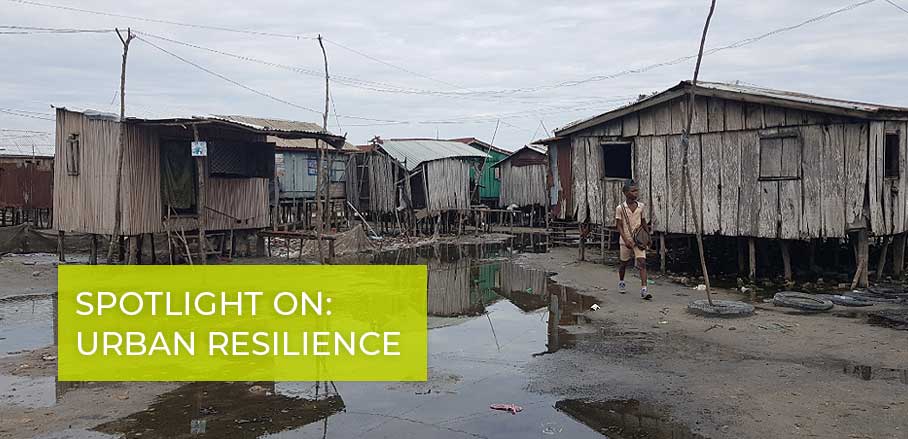Smart Cities and Slum Resilience
The concept of smart cities brings with it both risks and opportunities for informal settlements. Through technical innovation, they do have the potential of making slums more resilient, argues Laurinda Godjo – if they are not only smart cities but also inclusive cities.
Two major revolutions during the 21st century enabled the notion of smart cities: massive urbanisation and the explosion of new information technologies. “Smart cities” means that everything in these cities is designed to be intelligent, including infrastructure, energy, housing, grids, and mobility.
With continuing urbanisation often comes a growth of slums. In this regard, the question arises, what will the advent of smart cities contribute to the slums that are an integral part of so many of today’s cities? Will the smart city enhance slum resilience? And, just as important, will the inhabitants of these slums be resilient enough to the threats that smart cities can pose to their very existence?
Smart cities could have both positive and negative impacts on slums. However, one condition must define these impacts: their potential of inclusion.
Truly Smart Cities Are Inclusive Cities
“Leaving No one Behind” is the goal of the New Urban Agenda. Following that call, smart cities will be measured by their level of inclusion. The goal of inclusion requires a resilience strategy with regards to slums that reflect a two-way understanding of resilience:
Generally, urban resilience is considered as the ability of the city to absorb both chronic stresses and acute shocks and recover its functions. Thus, one way that resilience could be understood with regards to slums would be as their ability to adapt to the multiple changes and innovations that smart cities will bring. In another way, smart cities themselves need to adapt to the existence of urban poor communities.
Smart cities, in order to contribute to slum resilience, must therefore be inclusive. If they are not inclusive, we witness massive forced evictions, as has been the case in the Republic of Benin, where on August 20, 2019, 160 houses were demolished in Wxlacodji, the oldest slum in Cotonou. Following a mere 72-hour notice, the slum dwellers helplessly saw their homes destroyed by bulldozers – because the government aims to transform Cotonou and raise it to the level of cities such as Kigali, Lagos, or Dubai that are planned and remodelled according to the idea of a smart city.
Unfortunately, no measures have been taken so far to relocate these forced eviction victims in Wxlacodji. Nearly a dozen slum communities, housing about 3000 inhabitants, are also preparing to see their settlements, see the results of their efforts, disappear one morning. This is a phenomenon we risk seeing in almost all African countries, if smart cities are not planned in an inclusive way.
Smart Cities for Slum Resilience
However, smart cities have an enormous potential to make slums more resilient to chronic stresses, thanks to the various technological innovations they will bring and that will be implemented in the urban system. For example, with new technologies, slums can be easily mapped and consequently will be taken into account in the development plan of the respective cities.
This is the case in cities where a network of grassroots organisations called Shack/Slum Dwellers International (SDI) has affiliated organisations. Together, they promote community-based data collection in slums, so these urban poor are not overlooked in the provision of basic services such as housing, water, schools, and sanitation.
Residents in slums communities are taught to use GPS devices to profile their communities. They collect data on the existing facilities in the communities, the number of inhabitants, the borders of the communities, as well as the history of the communities through digital questionnaires.
These profiles are created in slums communities in 33 countries and help design a participative development planning of these communities. These plans will be introduced to the cities’ authorities, so that they can be integrated in their own city plan. This process is ongoing in Cotonou, Benin, with Justice Empowerment Initiative (JEI), an affiliated organisation of SDI.
The current gap between urban dwellers who can live in healthy conditions and those living in slums, being exposed to various health hazards, is large. This gap is linked mostly to the lack of two things: infrastructure and education. Few residents of these informal neighborhoods, and especially children, have access to technological devices such as computers, tablets, and smartphones. The smart city – if it is inclusive – will allow these children to have access to the same information and digital education as others. This is the goal of Craft Silicon Foundation which tours slums in Kenya to educate children on digital devices with its mobile computer lab, a bus equipped with computers, printers, scanners, etc.
Smart cities will only be a truly sustainable system to cities if they are smart enough to be inclusive, and to make slums communities resilient to both chronic stresses and the changes that they themselves will bring.
- Smart Cities and Slum Resilience - 8. October 2019
- Having a Say in What Affects Your Life: Youth Participation in Kumasi, Ghana - 21. February 2019
